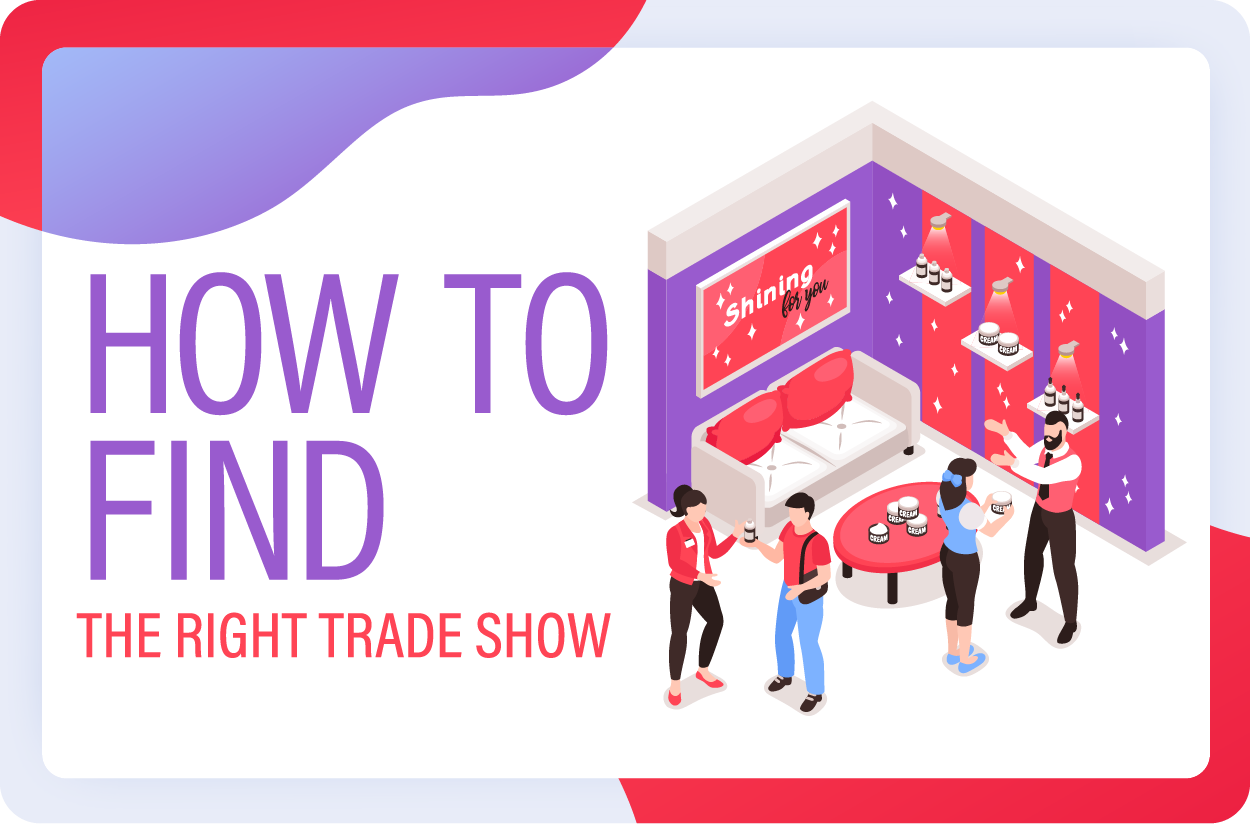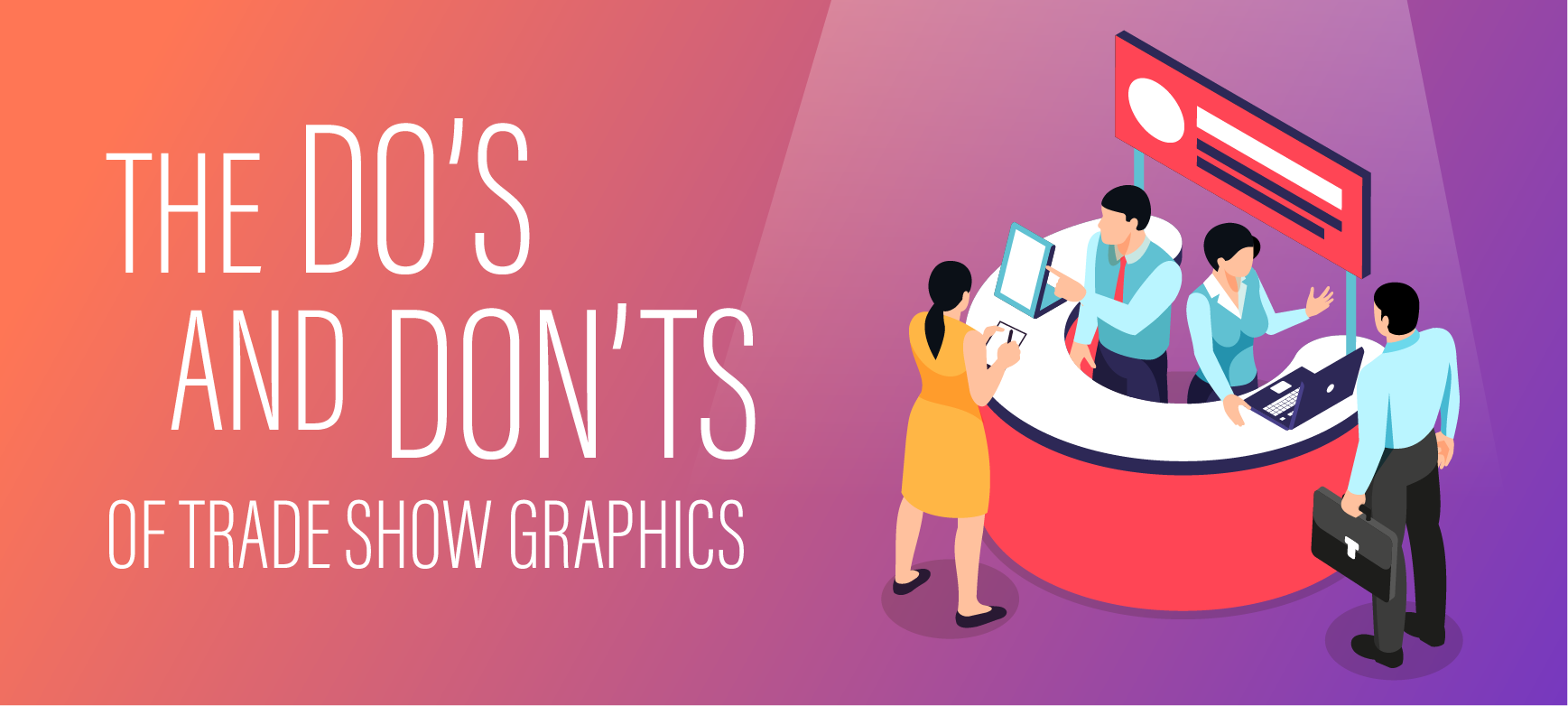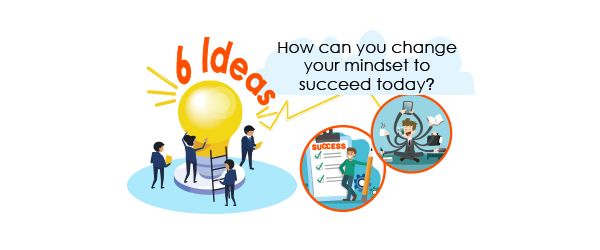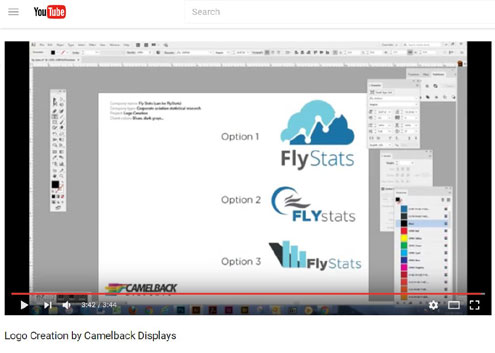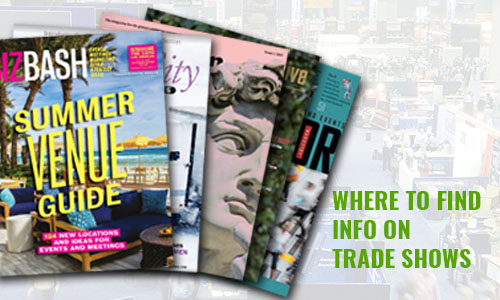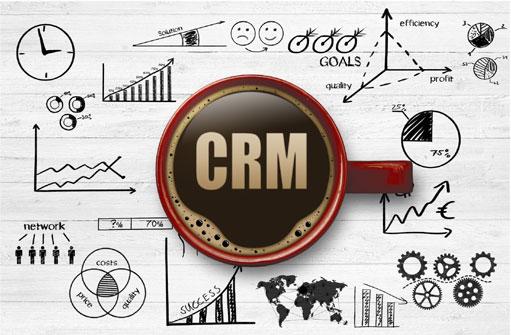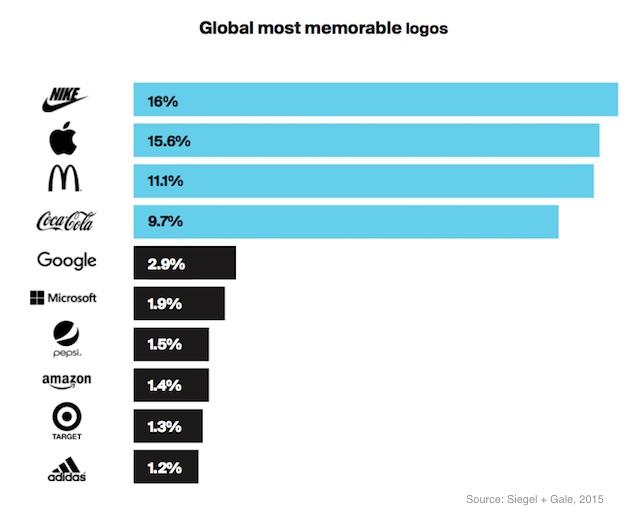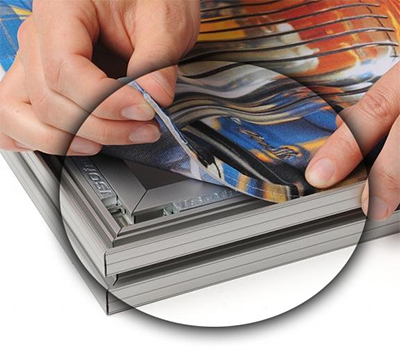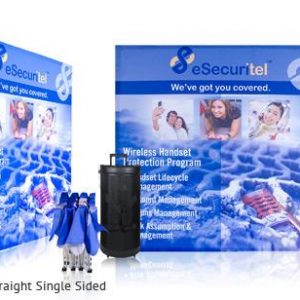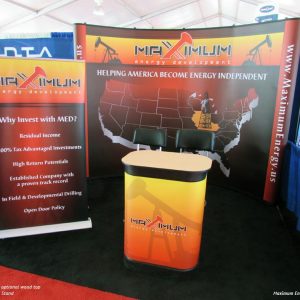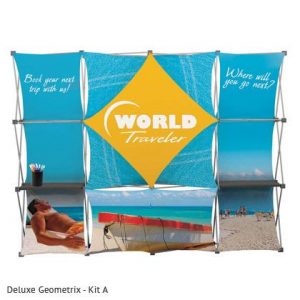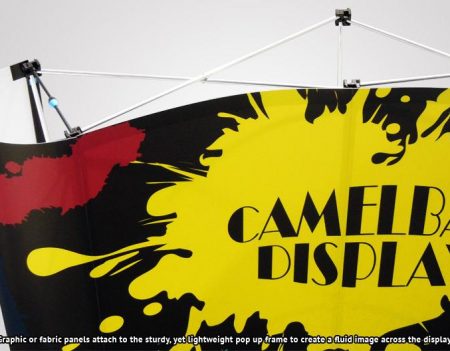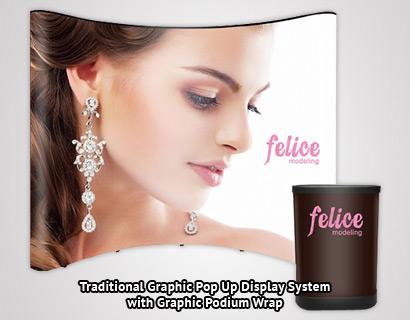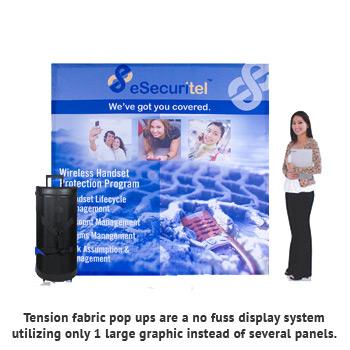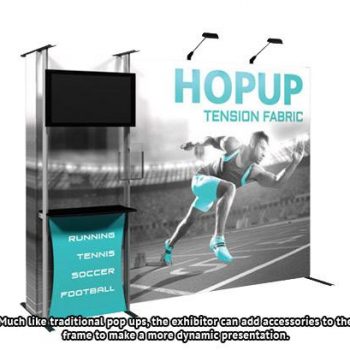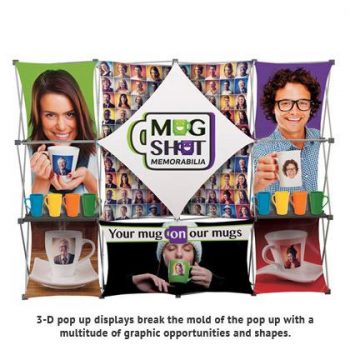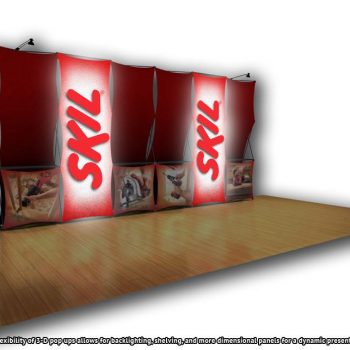With the vast array of display products that exist for Exhibitors needing portable solutions, the pop up display is a great choice. It is extremely portable, versatile and offers a look that is as modern as the graphics that you use. Pop Up back walls can look full and weighty, despite their light weight construction. They are perfect for multiple indoor venues and have been the workhorse for millions of companies over the years that need a terrific display on a tight budget.
Pop Up Trade Show Displays
Originally, the traditional pop up display consisted of an expandable frame that resembled a Geodesic Dome. Vertical struts were added for support and rollable, Hook & Loop receptive fabric panels were hung to the face of the frame using magnets that attached to the struts. This way, you could attach graphics onto the display and change them as needed. That same system is still used today and has been improved upon dramatically.
Now, a pop up can be ordered with full graphic panels, one-piece full color dye-sublimation printed fabric panels or stretchable flags. The display can even be back-lit. There are a lot of different shapes that can be made using the simple frame along with panels, shelving, lights and monitor holders. This helps to keep the ubiquitous pop up display relevant.
TRADITIONAL POP UP DISPLAYS
As stated above, this is the classic display that easily comes together to fill up a space. Add graphics, shelves, monitor holders, bubble panels, back lighting and make different shapes to suit your particular needs.
Order with fabric or graphic panels or add a podium wrap that covers the case and creates an opportunity for branding and gives you the utility of a counter (without the podium wrap, you have to hide or store the case).
We recommend, due to the drop in prices for graphics to order Mural Kits, which include printed graphic panels.
Frames:
“Accordion out” for quick set up. Usually they are made of lightweight round aluminum tubes joined together at “hub’s, which allow struts (channel bars) to be hung for extra support. Most manufacturers offer a lifetime frame warranty for this part of the display. (Check the warranty details for each model) The design allows the frame to be easily collapsed and packed away in a case for storage and shipping.
Struts or Channel Bars:
These are vertical frame supports that make the frame a little stronger and allow the panels to be hung using magnets. They attach in various non-complex ways to the frame hubs. Some slip on. Others use magnets or a clip on design. Some allow the attachment of lights at the top or have notches in the center to hang shelves or monitor holders. For standard systems, struts are used in the front and sides, unless you are adding panels to the back.
Cases:
Designs vary. Pop up cases are usually made of roto-molded plastic with a removable top and wheels on one side. Some case tops can be used as a step stool to assist with hanging panels, graphics or lights. Lights usually have a compartment inside the top for safe storage in foam. They are designed for safely packing the parts of the display to minimize damage to hardware and panels during shipping or storage.
Panels are usually packed separately from hardware or protected from it in some way (critical). Most single wall systems, like 8’ and 10’ exhibits will fit in one case. If extra accessories or panels are ordered, always make sure there is room inside the case for everything. Usually the original kit packs tight, so consider ordering additional cases as needed.
Podium Wraps:
Podium wraps are graphic or fabric panels that simply Hook & Loop to the case to cover it up. They offer a smooth shell that makes the case look like a counter. Various counter tops are available, ranging from ABS plastic and Sintra to laminate wood. It’s also possible to affix vinyl graphics to the tops.
Otherwise known as case-to-podium conversion kits, podium wraps turn the pop up carry case into a meet and greet counter, a place to display a product or literature, and another location to showcase your brand. Another advantage is since the case is being used as a podium, you don’t have to store it anywhere, which could actually save you money at some show venues.
Lights:
Attach to the top of the frame using special clips or depending on the model, clip onto the top of the channel bar. Pop up display lights plug into standard outlets. The trend in the exhibit industry is moving toward LED display lights, which use less energy, emit less heat and offer white light.
Standard halogen and incandescent lights are still available too. Some venues are limiting their use to 150 watts or lower. LED’s don’t have that problem and can be used everywhere. They also last longer.
Graphic / Fabric Panels:
Traditional pop ups use rollable fabric or graphic panels that attach to the face of the frame using magnets. Graphic panels can be printed on different media depending on the brand. Direct printed panels are usually made using Sintra, which is a rollable PVC media. This is done to keep printing expenses down while maintaining quality and is one of the reasons mural pop up display kits are so inexpensive. The only problem with direct print panels is that they do not completely block out light (they block most of it), but this is only a problem with hard direct lighting behind the display. Most trade show booths are made of pipe & drape, which covers the back anyway, blocking any stray light.
Another way pop up graphics are printed are with a combination of an opaque film and lamination. The film is printed on the face and the back is made of a light blocking coating. After printing, the film is laminated to protect the graphic. Film printing is usually more expensive than direct printing on Sintra but is considered higher end. However, most people looking at two displays sitting side by side with one printed on film and the other direct printed, would not be able to tell any difference at all. When packing any graphic panels, be sure to roll them with the image facing out. This helps to prevent the laminate from coming off the face of the panels. Not only that, if panels are rolled with the graphic image inside, then your panels may not hang right. This is a common mistake. All mural graphic panels are subject to damage if you mistreat them.
Be careful when rolling and unrolling. One hard crimp on the surface can ruin the look of your display. If you have to lay them on the floor, make sure the floor is clean and free of anything that could scratch your graphics. When packing them back in the case, keep the panels protected from any hardware that could poke holes or cause crimps.
Benefits:
- Traditional pop ups offer and ease of set up and portability that is missing from custom exhibits.
- Quick set up allows someone to display with a pop up exhibit in more and varied venues. This is important when you have to get in, set up quickly, have your presentation and move on.
- Fabric unprinted versions that allow graphic attachment with Hook & Loop gives exhibitors the opportunity to change out graphics easily from show to show. Let’s say your company exhibits at multiple trade shows for different things; this lets you have a different set of graphics for each show.
- Mural graphic printed pop ups offer on of the highest impact looks, depending on the graphics.
- The kits are usually self-contained units with everything packed inside the case and ready to be set up. If the pop up is all you are using, then all you worry about is one case.
- Pop up wall displays are affordable.
- They are reusable and can last for years if properly taken care of during set-up, tear down and packing.
- These displays are adaptable & flexible. Showcase products and graphics, hang monitors, present using backlighting, utilize slat wall, add bubble panels, make different display shapes and much more. This is one reason, they are considered as a standard display for trade shows.
TENSION FABRIC POP UP DISPLAYS
This type of pop up exhibit utilizes full color fabric graphics that are printed in one piece and usually stay on the display for storage. This means that set up is even more minimal. Simply open the frame, put it in place and you are ready to go. There is less set up because the graphic panel (note “panel” is singular) is already attached to the frame hubs via Hook & Loop.
When the tension fabric pop up frame is opened, the fabric mural graphic is stretched taught. This means that unlike traditional pop ups, where you have 6 panels to hang on a 10’ curve model, there is nothing to hang and no struts to attach because the fabric graphic is already attached.
Frames:
Standard pop up frames are used, but they are more beefy with extra frame connectors or locks. The tubes used are sometimes thicker and the frame usually has a deeper footprint.
Setting up the frame is pretty much the majority of the work in set up which reduces time in getting ready for a presentation, so this type of pop up is great for not only trade shows, but any presentation where you need a quick set up.
Cases:
Cases can be standard roto molded pop up cases (though smaller) or nylon carry bags that are usually padded.
These cases do not usually offer a podium wrap, but you can always upgrade to another case that does.
Lights:
Standard pop up lights are available and not always included due to the type of display this is.
Lights will attach to the frame top either by clamping on or with a special bracket that fits in the frame scissors.
Graphic Panels:
Graphic panels are made of a single piece, dye sublimation graphics. They are full color fabric prints that usually remain attached to the frame and are made of various types of printable stretchy material. Some units wrap around the ends or just cover the front with the sides exposed.
We always recommend ordering units that cover the ends. Some models offer backlit panels, but most are front lit. The real benefit is the ease of set up and once in place, the displays look professional, full and fill up a space just like traditional pop up displays. Note that because fabric graphics are used, they are not opaque and should not be used in front of hard light sources, such as a sunny window. Some models offer opaque backing as an accessory.
Benefits
- Ease of set up and portability.
- Tension fabric graphics are usually left attached to the pop up frame. This is a huge benefit in how long it takes to set up the display and pack it down.
- The graphic is one-piece, which means you don’t have multiple panels to hang (or damage in the process).
- Fabric graphic panels cannot be crimped or have permanent creases inflicted upon them like traditional mural panels can. Fabric graphics can be folded and have any wrinkles steamed out. Since they are pulled taught, this also minimizes wrinkles.
- The different shapes of tension fabric pop ups offer unique design options and can be combined with other types of displays and accessories for effect and utility.
3D POP UP DISPLAYS
Imagine the simplicity of the pop up frame. Then add beautifully printed flag graphics in different shapes, along with backlighting, counters or shelves and you have a versatile display that can be used in point of purchase, as an exhibit at a trade show, a portable demo display, a banner stand and lots more. 3D pop ups use graphic flags printed on stretchable fabric that are attached to the frame in a number of different ways with unique effects.
You can create a standard pop up display with different sized flags attached to different parts of it or something completely out of the box like a model that resembles a pyramid. Use this style of pop up to add a little pizazz to your presentation and to display lightweight products in different ways. One reason we call it “3D” is because with this pop up, you are not limited to front or back flat surfaces. The frame quads (quadrants) can hold these flags in a number of ways: flat front, back to front, flat back, rotated and so on. You can even stretch some flags across several quads and overlap in other areas.
Frames:
This is a fairly strong pop up frame that doesn’t use struts. Special hubs allow the attachment of the flags to the frame, which is more open with fewer or no X’s in the frame quadrants.
This allows the flags to be hung in various patterns for different effects.
Lights:
Pop up lights are available and backlighting kits are also common. For example, we offer a 3D pop up that has the ability to back light with its own custom light box that encloses a set of LED lights in a flexible plastic box that can also stay attached to the frame or be removed for packing.
Cases:
Most come with a nylon carry bag, but you can upgrade to a roto molded case.
Graphic Panels:
Graphics are stretchable full color printed flags that attach to the hubs. Flags are stretchy, but are made to fit a particular configuration. You can’t for example; stretch a single quad flag across two quads but you can move them around the frame as long as the size is the same.
Flags remain attached to most models of 3D pop ups for packing. The graphic flags are printed using dye sublimation, which renders vibrant full color onto fabric.
Benefits
- Set up is a breeze.
- Graphic flags are usually left on the frame, just like tension fabric pop ups.
- Graphic flags of different shapes and configurations offer unique and unlimited design options.
- Truly unique shapes that other pop up systems don’t offer.
- Display products and graphics effectively due to the open nature of the frame.
- 3D Pop ups offer many presentation solutions that bleed over in point of purchase, exhibiting, demonstrations and product displays.
POP UP TIPS
All Pop Ups:
- Take care of your display and it will last a long time. Try to store it in an air-conditioned environment and avoid hot warehouses with high humidity. Pack and store the display correctly to avoid damage. Handle the graphics without causing creases, crimps or tears.
- Take pictures of how the case is packed and set up. Keep them in the case along with set up instructions. This will save you from making a mistake in repacking and show you what it is supposed to look like all set up. Good idea for custom configurations.
- When opening a pop up frame, hold it in the middle and expand. Don’t open from the side, in the air or at an angle. Keep it on your surface.
- Put your contact information inside the case. In the event your display gets lost in transit or the shipping information gets damaged, someone can figure out who it belongs to. I would put contact information inside the top and in the case itself.
Traditional Pop Ups:
- Rollable graphic panels and detachable graphics should be rolled with the image side out. This helps protect them from delamination and helps maintain their shape. For example, if the end panels are rolled image side in, it makes it difficult for them to wrap around to the back of the frame and stick to it, no matter how powerful your magnets are.
- Never lay traditional pop up panels on a dirty floor or abrasive surface to avoid scratches and damage to the face of your graphics.
- To hang graphic or fabric panels straight on traditional pop ups, first start with a level surface and hang panels left to right. Make sure the first panel is hung absolutely straight with the edges perfectly centered on the magnetic struts and the rest will be easier to hang straight. If you are having trouble getting panels to stick to their magnets, the first thing to check is to make sure everything is straight. Magnets have to align in order to work the best (also make sure the magnetic surfaces are dust free).
- For fabric Hook & Loop receptive pop ups, bring along a lint roller to your event to keep the panels free of lint.
- If you are having trouble collapsing the frame when it’s time to pack it down, this may be due to a stray channel bar being left on the frame. Never force the frame to close because you will bend frame tubes.
